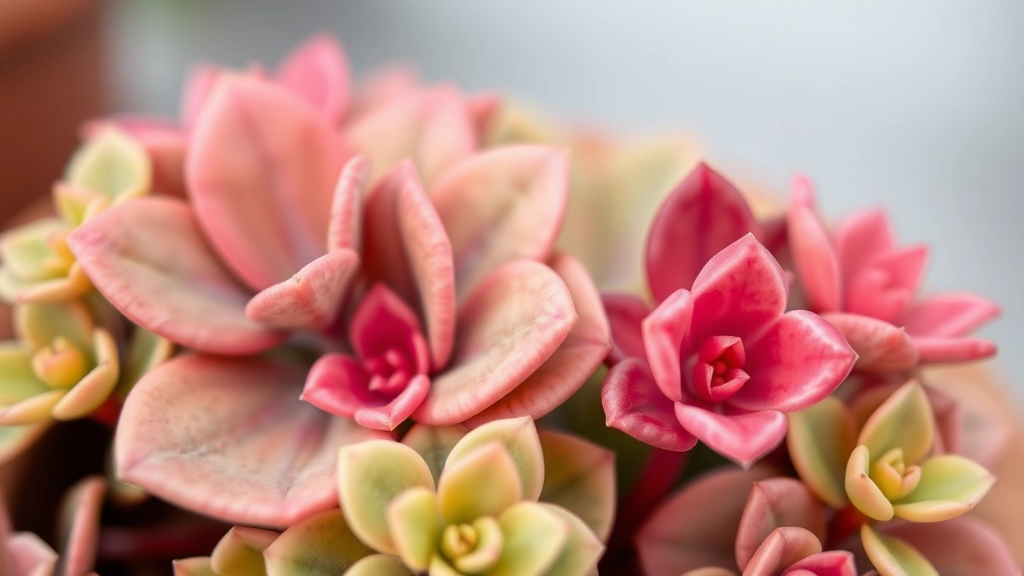Welcome to the Enchanting World of Kalanchoe Succulent Pink
Welcome to the enchanting world of the kalanchoe succulent pink, a captivating plant that’s as resilient as it is beautiful. In this article, we’ll explore the unique charm of Kalanchoe Pink Butterflies, a succulent that’s captured the hearts of plant enthusiasts with its delicate, butterfly-like plantlets and easy-care nature.
From its ideal growing conditions and propagation methods to troubleshooting common issues, we’ll cover everything you need to know about this remarkable plant. Whether you’re a seasoned gardener or a novice plant parent, you’ll discover why the Kalanchoe Pink Butterflies is a must-have addition to your succulent collection.
Kalanchoe Pink Butterflies: The Basics
Ever seen a plant that looks like it’s covered in tiny pink butterflies? That’s our star today.
Kalanchoe Pink Butterflies isn’t just a pretty face. It’s a tough little succulent that’s got some tricks up its sleeve.
Here’s the deal:
- It’s part of the Kalanchoe family
- Known for its unique plantlets that look like pink butterflies
- Easy to care for (perfect if you’re not exactly a plant whisperer)
Growing Conditions: What This Plant Needs
Let’s talk about keeping this beauty happy.
Sunlight and Temperature
Kalanchoe Pink Butterflies loves the sun, but not too much.
- Bright, indirect light is ideal
- Can handle a bit of direct morning sun
- Prefers temperatures between 15-25°C (59-77°F)
Soil and Water
This plant’s not fussy, but it does have some preferences.
- Well-draining soil is a must
- Mix regular potting soil with some perlite or sand
- Water when the top inch of soil feels dry
Propagation: Making More Pink Butterflies
Want more of these beauties? You’re in luck. They’re super easy to propagate.
Plantlet Propagation
Those little pink “butterflies” aren’t just for show.
- Gently remove plantlets when they’re about 2cm long
- Place them on well-draining soil
- Mist lightly and watch them grow
Leaf and Stem Cuttings
Another way to multiply your plant:
- Cut a healthy leaf or stem
- Let it callous over for a day or two
- Plant in well-draining soil
- Keep slightly moist until roots form
Common Problems: Troubleshooting Your Plant
Even the toughest plants can have issues. Here’s what to watch for:
Overwatering and Underwatering
Finding the right balance is key.
- Overwatered: Leaves look mushy and translucent
- Underwatered: Leaves wrinkle and feel crispy
Pest Control
Keep an eye out for these little buggers:
- Mealybugs: Look like tiny cotton balls
- Aphids: Small, usually green insects
If you spot them, wipe them off with rubbing alcohol on a cotton swab.
Remember, Kalanchoe Pink Butterflies is a resilient plant. With a bit of care, it’ll thrive and keep producing those adorable pink plantlets.
FAQs about Kalanchoe Pink Butterflies
Q: How often should I water my Kalanchoe Pink Butterflies?
A: Water your Kalanchoe Pink Butterflies when the top inch of soil feels dry. This succulent is drought-tolerant, so it’s better to underwater than overwater. Typically, this means watering every 1-2 weeks, depending on your climate and the plant’s environment.
Q: Can I grow Kalanchoe Pink Butterflies outdoors?
A: Yes, you can grow Kalanchoe Pink Butterflies outdoors in suitable climates. They thrive in USDA hardiness zones 9-11. If you live in a colder area, you can keep them outside during warm months but bring them indoors when temperatures drop below 50°F (10°C).
Q: Why are the plantlets on my Kalanchoe Pink Butterflies turning green?
A: The pink color of the plantlets is often more pronounced when the plant is under some stress, particularly from bright light. If your plantlets are turning green, it might mean the plant is very happy and healthy, but getting less intense light. Try moving it to a slightly brighter spot to encourage more pink coloration.
Q: Is Kalanchoe Pink Butterflies toxic to pets?
A: Yes, like many Kalanchoe species, Pink Butterflies can be toxic if ingested by pets or children. It’s best to keep this plant out of reach of curious pets and young children.
Q: How big does Kalanchoe Pink Butterflies grow?
A: Kalanchoe Pink Butterflies typically grows to about 12-18 inches (30-45 cm) tall and wide. However, its size can vary depending on growing conditions and care.
Q: Do I need to fertilize my Kalanchoe Pink Butterflies?
A: While not absolutely necessary, you can fertilize your Kalanchoe Pink Butterflies during the growing season (spring and summer) with a balanced, water-soluble fertilizer diluted to half strength. Apply every 4-6 weeks for optimal growth.

